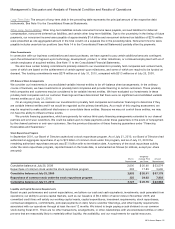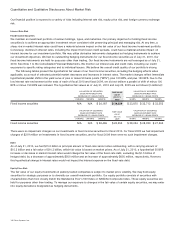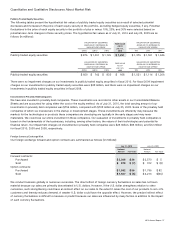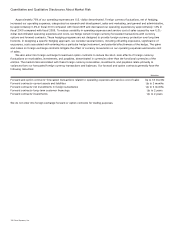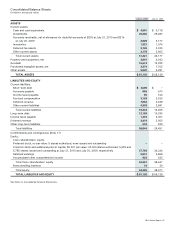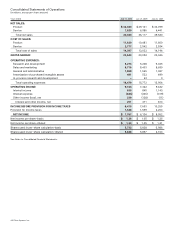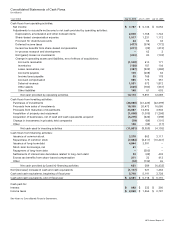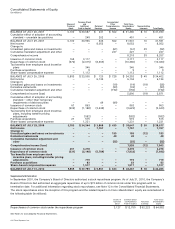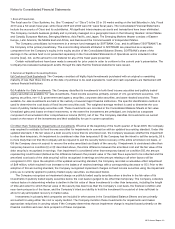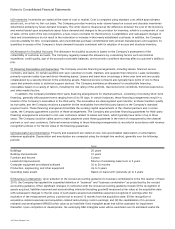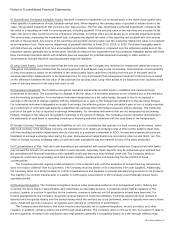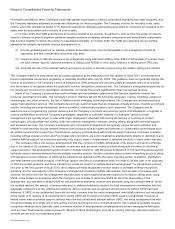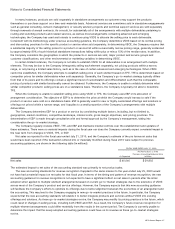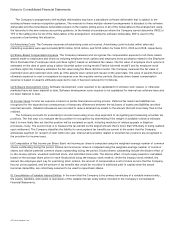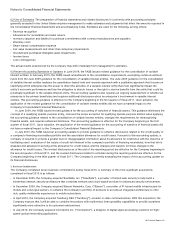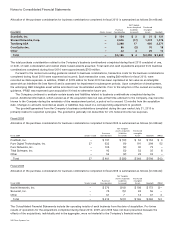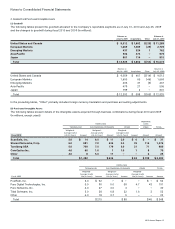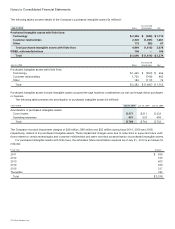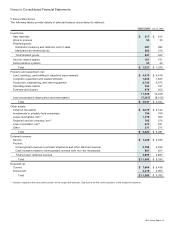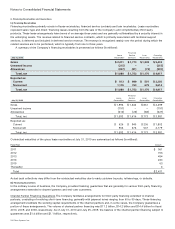Cisco 2010 Annual Report Download - page 47
Download and view the complete annual report
Please find page 47 of the 2010 Cisco annual report below. You can navigate through the pages in the report by either clicking on the pages listed below, or by using the keyword search tool below to find specific information within the annual report.
Notes to Consolidated Financial Statements
(i) Goodwill and Purchased Intangible Assets Goodwill is tested for impairment on an annual basis in the fourth fiscal quarter and,
when specific circumstances dictate, between annual tests. When impaired, the carrying value of goodwill is written down to fair
value. The goodwill impairment test involves a two-step process. The first step, identifying a potential impairment, compares the
fair value of a reporting unit with its carrying amount, including goodwill. If the carrying value of the reporting unit exceeds its fair
value, the second step would need to be conducted; otherwise, no further steps are necessary as no potential impairment exists.
The second step, measuring the impairment loss, compares the implied fair value of the reporting unit goodwill with the carrying
amount of that goodwill. Any excess of the reporting unit goodwill carrying value over the respective implied fair value is recognized
as an impairment loss. There was no impairment of goodwill identified in fiscal 2010, 2009, or 2008. Purchased intangible assets
with finite lives are carried at cost, less accumulated amortization. Amortization is computed over the estimated useful lives of the
respective assets, generally two to seven years. See below related to the impairment test for purchased intangible assets with finite
lives. Purchased intangible assets with indefinite lives are assessed for potential impairment annually or when events or
circumstances indicate that their carrying amounts might be impaired.
(j) Long-Lived Assets Long-lived assets that are held and used by the Company are reviewed for impairment whenever events or
changes in circumstances indicate that the carrying amount of such assets may not be recoverable. Determination of recoverability
of long-lived assets is based on an estimate of the undiscounted future cash flows resulting from the use of the asset and its
eventual disposition. Measurement of an impairment loss for long-lived assets that management expects to hold and use is based
on the difference between the fair value of the asset and its carrying value. Long-lived assets to be disposed of are reported at the
lower of carrying amount or fair value less costs to sell.
(k) Derivative Instruments The Company recognizes derivative instruments as either assets or liabilities and measures those
instruments at fair value. The accounting for changes in the fair value of a derivative depends on the intended use of the derivative
and the resulting designation. For a derivative instrument designated as a fair value hedge, the gain or loss is recognized in
earnings in the period of change together with the offsetting loss or gain on the hedged item attributed to the risk being hedged.
For a derivative instrument designated as a cash flow hedge, the effective portion of the derivative’s gain or loss is initially reported
as a component of AOCI and subsequently reclassified into earnings when the hedged exposure affects earnings. The ineffective
portion of the gain or loss is reported in earnings immediately. For derivative instruments that are not designated as accounting
hedges, changes in fair value are recognized in earnings in the period of change. The Company records derivative instruments in
the statements of cash flows to operating, investing or financing activities consistent with the cash flows of the hedged item.
(l) Foreign Currency Translation Assets and liabilities of non-U.S. subsidiaries that operate in a local currency environment, where
that local currency is the functional currency, are translated to U.S. dollars at exchange rates in effect at the balance sheet date,
with the resulting translation adjustments directly recorded to a separate component of AOCI. Income and expense accounts are
translated at average exchange rates during the year. Remeasurement adjustments are recorded in other income (loss), net. The
effect of foreign currency exchange rates on cash and cash equivalents was not material for any of the years presented.
(m) Concentrations of Risk Cash and cash equivalents are maintained with several financial institutions. Deposits held with banks
may exceed the amount of insurance provided on such deposits. Generally, these deposits may be redeemed upon demand and
are maintained with financial institutions with reputable credit and therefore bear minimal credit risk. The Company seeks to
mitigate its credit risks by spreading such risks across multiple counterparties and monitoring the risk profiles of these
counterparties.
The Company performs ongoing credit evaluations of its customers and, with the exception of certain financing transactions,
does not require collateral from its customers. The Company receives certain of its components from sole suppliers. Additionally,
the Company relies on a limited number of contract manufacturers and suppliers to provide manufacturing services for its products.
The inability of a contract manufacturer or supplier to fulfill supply requirements of the Company could materially impact future
operating results.
(n) Revenue Recognition The Company recognizes revenue when persuasive evidence of an arrangement exists, delivery has
occurred, the fee is fixed or determinable, and collectibility is reasonably assured. In instances where final acceptance of the
product, system, or solution is specified by the customer, revenue is deferred until all acceptance criteria have been met. For
hosting arrangements, the Company recognizes revenue based on customer utilization. Technical support services revenue is
deferred and recognized ratably over the period during which the services are to be performed, which is typically from one to three
years. Advanced services revenue is recognized upon delivery or completion of performance.
The Company uses distributors that stock inventory and typically sell to systems integrators, service providers, and other
resellers. In addition, certain products are sold through retail partners. The Company refers to this as its two-tier system of sales to
the end customer. Revenue from distributors and retail partners generally is recognized based on a sell-through method using
2010 Annual Report 45


